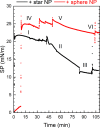Shape-dependent gold nanoparticle interactions with a model cell membrane
- PMID: 36347646
- PMCID: PMC9646251
- DOI: 10.1116/6.0002183
Shape-dependent gold nanoparticle interactions with a model cell membrane
Abstract
Customizable gold nanoparticle platforms are motivating innovations in drug discovery with massive therapeutic potential due to their biocompatibility, stability, and imaging capabilities. Further development requires the understanding of how discrete differences in shape, charge, or surface chemistry affect the drug delivery process of the nanoparticle. The nanoparticle shape can have a significant impact on nanoparticle function as this can, for example, drastically change the surface area available for modifications, such as surface ligand density. In order to investigate the effects of nanoparticle shape on the structure of cell membranes, we directly probed nanoparticle-lipid interactions with an interface sensitive technique termed sum frequency generation (SFG) vibrational spectroscopy. Both gold nanostars and gold nanospheres with positively charged ligands were allowed to interact with a model cell membrane and changes in the membrane structure were directly observed by specific SFG vibrational modes related to molecular bonds within the lipids. The SFG results demonstrate that the +Au nanostars both penetrated and impacted the ordering of the lipids that made up the membrane, while very little structural changes to the model membrane were observed by SFG for the +Au nanospheres interacting with the model membrane. This suggests that the +Au nanostars, compared to the +Au nanospheres, are more disruptive to a cell membrane. Our findings indicate the importance of shape in nanomaterial design and provide strong evidence that shape does play a role in defining nanomaterial-biological interactions.
Figures




References
-
- Bathe M. and Rothemund P. W. K., MRS Bull. 42, 882 (2017). 10.1557/mrs.2017.279 - DOI
Publication types
MeSH terms
Substances
Grants and funding
LinkOut - more resources
Full Text Sources

